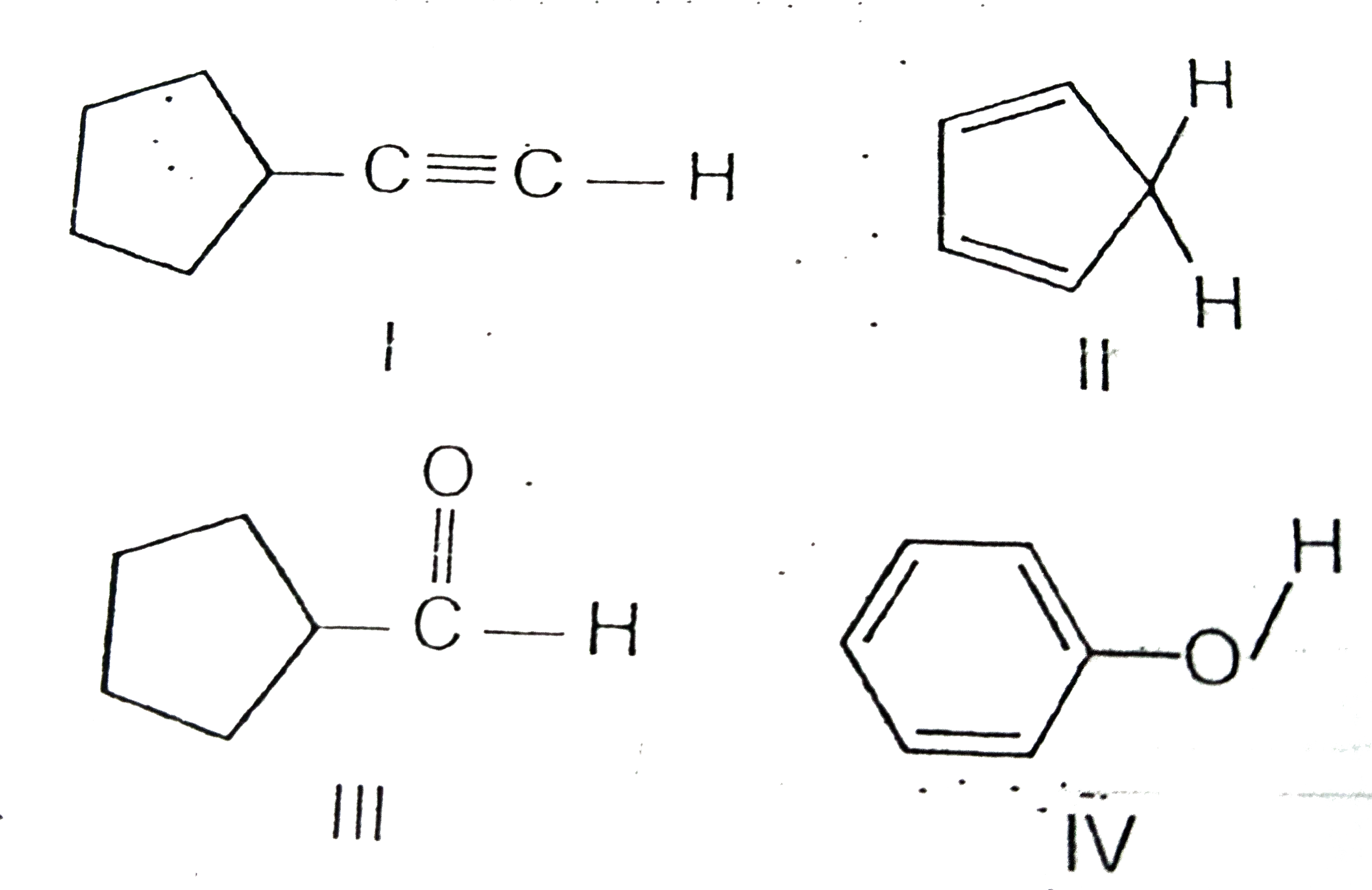Arrange the following acids in the decreasing order of acid strength: (i) Benzoic acid (ii) o-Chlorobenzoic acid (iii) m-Chlorobenzoic acid (iv) p-Chlorobenzoic acid.
To arrange the given acids in decreasing order of acid strength, we will analyze the effects of substituents on the benzoic acid structure. The compounds we need to compare are:
1. Benzoic acid (C6H5COOH)
2. o-Chlorobenzoic acid (C6H4ClCOOH)
3. m-Chlorobenzoic acid (C6H4ClCOOH)
4. p-Chlorobenzoic acid (C6H4ClCOOH)
Step 1: Understanding Acid Strength
Acid strength is influenced by the stability of the conjugate base formed after the acid donates a proton (H+). The more stable the conjugate base, the stronger the acid.
Step 2: Analyzing the Effects of Chlorine Substituents
Chlorine is an electron-withdrawing group due to its -I (inductive) effect. It can stabilize the negative charge on the conjugate base through this effect. However, chlorine also has a +M (mesomeric) effect, which can destabilize the conjugate base when it is in the ortho or para position.
Step 3: Evaluating Each Compound
1. Benzoic Acid: No substituent, baseline acidity.
2. o-Chlorobenzoic Acid: The chlorine in the ortho position exerts a strong -I effect, which increases acidity significantly due to the ortho effect. The -I effect from chlorine outweighs the destabilizing +M effect in this case.
3. m-Chlorobenzoic Acid: The chlorine in the meta position only exerts a -I effect. This increases acidity but is less effective than the ortho effect.
4. p-Chlorobenzoic Acid: The chlorine in the para position also exerts a -I effect, but it is less effective than the ortho effect. The +M effect is not as significant in this case.
Step 4: Ranking the Acids
Based on the analysis:
- o-Chlorobenzoic acid will be the strongest acid due to the ortho effect.
- m-Chlorobenzoic acid will be next, as it has a -I effect but lacks the ortho effect.
- p-Chlorobenzoic acid follows, as it has a -I effect but is less effective than the meta position.
- Benzoic acid will be the weakest, as it has no substituents to enhance acidity.
Final Order of Acidity
The decreasing order of acid strength is:
1. o-Chlorobenzoic acid
2. m-Chlorobenzoic acid
3. p-Chlorobenzoic acid
4. Benzoic acid
2. o-Chlorobenzoic acid (C6H4ClCOOH)
3. m-Chlorobenzoic acid (C6H4ClCOOH)
4. p-Chlorobenzoic acid (C6H4ClCOOH)
Acid strength is influenced by the stability of the conjugate base formed after the acid donates a proton (H+). The more stable the conjugate base, the stronger the acid.
Chlorine is an electron-withdrawing group due to its -I (inductive) effect. It can stabilize the negative charge on the conjugate base through this effect. However, chlorine also has a +M (mesomeric) effect, which can destabilize the conjugate base when it is in the ortho or para position.
1. Benzoic Acid: No substituent, baseline acidity.
2. o-Chlorobenzoic Acid: The chlorine in the ortho position exerts a strong -I effect, which increases acidity significantly due to the ortho effect. The -I effect from chlorine outweighs the destabilizing +M effect in this case.
3. m-Chlorobenzoic Acid: The chlorine in the meta position only exerts a -I effect. This increases acidity but is less effective than the ortho effect.
4. p-Chlorobenzoic Acid: The chlorine in the para position also exerts a -I effect, but it is less effective than the ortho effect. The +M effect is not as significant in this case.
Based on the analysis:
- o-Chlorobenzoic acid will be the strongest acid due to the ortho effect.
- m-Chlorobenzoic acid will be next, as it has a -I effect but lacks the ortho effect.
- p-Chlorobenzoic acid follows, as it has a -I effect but is less effective than the meta position.
- Benzoic acid will be the weakest, as it has no substituents to enhance acidity.
The decreasing order of acid strength is:
1. o-Chlorobenzoic acid
2. m-Chlorobenzoic acid
3. p-Chlorobenzoic acid
4. Benzoic acid
Topper's Solved these Questions
- BOOK - ICSECHAPTER - ALDEHYDES, KETONES AND CARBOXYLIC ACIDSEXERCISE - EXERCISE (PART-I OBJECTIVE QUESTIONS)303videos
ALDEHYDES, KETONES AND CARBOXYLIC ACIDS
- BOOK - ICSECHAPTER - ALDEHYDES, KETONES AND CARBOXYLIC ACIDSEXERCISE - EXERCISE (PART-II DESCRIPTIVE QUESTIONS) (VERY SHORT QUESTIONS)282videos
ALDEHYDES, KETONES AND CARBOXYLIC ACIDS
- BOOK - ICSECHAPTER - ALCOHOLS, PHENOLS AND ETHERS EXERCISE - ISC EXAMINATION QUESTIONS25videos
ALCOHOLS, PHENOLS AND ETHERS
- BOOK - ICSECHAPTER - APPENDIX II ( TYPICAL CONVERSIONS)EXERCISE - AROMATIC CONVERSIONS98videos
APPENDIX II ( TYPICAL CONVERSIONS)
Similar Questions
Knowledge Check
- Question 1 - Select One
Arrange the following compounds in decreasing order of acidity
 AP>Q>S>RBQ>R>S>PCQ>P>R>SDR>P>Q>S
AP>Q>S>RBQ>R>S>PCQ>P>R>SDR>P>Q>S - Question 2 - Select One
Arrange the following compounds in decreasing order of acidity
 AP>Q>R>SBR>Q>P>SCS>P>R>QDS>P>Q>R
AP>Q>R>SBR>Q>P>SCS>P>R>QDS>P>Q>R - Question 3 - Select One
Arrange the following compounds in decreasing order of acidity
 AP>Q>R>SBQ>P>R>SCQ>R>P>SDS>Q>P>R
AP>Q>R>SBQ>P>R>SCQ>R>P>SDS>Q>P>R
Arrange the given species in the increasing order of acidic strength
 View Solution
View SolutionArrange the following compounds in decreasing order of acidity
 View Solution
View SolutionArrange the following compounds in decreasing order of acidity
 View Solution
View SolutionRearrange the following in the increasing order of acidic strength.
(i) benzoic acid (ii) p-methoxybenzoic acid (iii) o -methyoxybenzoic acidView SolutionArrange the following compounds in decreasing order of acidity :
 View Solution
View Solution


